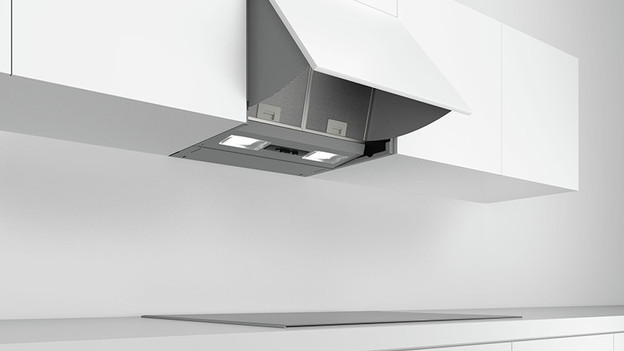
Written by Caitlin
Edited on
18 November 2024
·
13:59
How do you calculate the extraction rate of your range hood?
We all want a fresh kitchen that doesn't smell like yesterday's dinner. To achieve this, you need a range hood with an extraction rate large enough to handle your kitchen. Are you curious what this is exactly, how to calculate it, and which capacity you need to get your kitchen fume free? Read on.

What's an extraction rate?
The extraction rate is the maximum power of your range hood. It's expressed in cubic meters per hour. The capacity is the amount and speed the range hood extracts air from your kitchen with. This may vary for each brand and model. There are range hoods with an extraction rate of only 160m3, but there are also powerhouses with an extraction rate of 800m3 or more.
Note: the extraction rate is a property of a range hood with a motor that exhausts the air to the outside. This doesn't apply to recirculation range hoods or or motorless range hoods.

Calculate the required extraction rate
Do you have a closed kitchen? Multiply the volume of your kitchen (LxWxH) of your kitchen by 10. This is the minimum extraction rate you need to get your kitchen to smell fresh again. If you have an open kitchen, it's more difficult to calculate the extraction rate. That's because the air flows out to the living area. If you have an open kitchen, always choose a range hood with at least a 600m3 extraction rate.

Small kitchens
If the volume of your open kitchen is 20m3 at most, it's a small kitchen. Because these kitchens aren't large, you need a relatively low extraction rate. A range hood with a maximum extraction rate of 300m3 would already be enough.

Average kitchen
An average kitchen has a volume between 20 and 30m3. Depending on the size of your kitchen, you'll need a range hood with a minimum extraction rate between 300 and 400m3.

Large or open kitchen
A large kitchen has a volume of 30m3 or more. Open kitchens also belong to this category. The minimum extraction rate for these range hoods start at 400m3/h. If you have an open kitchen, go for an extraction rate of at least 600m3.

Check the drain
When you connect the exhaust pipe, make sure there are as few bends in the pipe as possible. With each bend, you lose 73m3 of extraction power. You should also make sure that the exhaust pipe has a diameter of at least 150mm. If the range hood extracts too much air and the pipe is too narrow, not all of the air is extracted and your kitchen will still smell like Brussels sprouts. You have to keep the pipe clean on the inside as well.

Right distance cooktop
Choose the right distance between the cooktop and range hood. If you mount the range hood too low, it won't work properly. You can find the right distance in the manual of your range hood. In addition, the range hood should be just as large as the cooktop to be able to extract all of the fumes. Preferably, the range hood should be wider.
Article by Caitlin
Range Hood Expert.
